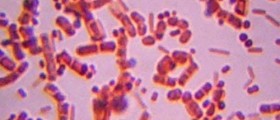
Staph Bacteria IntroductionStaph or Staphylococcus is a group of spheroid shaped bacteria that are often found in clusters similar to bunch of grapes. Staph bacteria are commonly present on the skin, in the nose, mouth, genitals and anal area of healthy individuals. However, Staph bacteria may cause an infection when they enter the body through cuts or other skin damages.
There are numerous types of Staphylococcus bacteria but Staphylococcus aureus strain is the most common cause of human infections. Under a microscope, S. aureus appears as grape-like structure in blue or violet color. There are two types of S. aureus - S. aureus anaerobius and S.aureus aureus but only the second one causes infections.
Staph Infection
Staphylococcus aureus commonly causes skin infection but may lead to severe disease as well, including meningitis, pneumonia, endorcarditis, toxic shock syndrome, osteomyelitis and septicemia. Staph infections are very contagious and are transmitted from person to person. The infection is easily spread through contact with pus from infected wounds or skin to skin contact.
Staph bacteria that normally live on the skin can enter the body via cut or scratch and cause skin infection. Staph infections of the skin include sty, pimples, boils, impetigo, cellulites, abscesses and others. Cellulitis is the most severe Staph skin infection and it affects deep layers of the skin. It commonly begins like small tender, red and swollen area and when spreads, it causes fever. Cellulitis requires prompt treatment.
Symptoms of Staph Infection
Symptoms of Staph infection vary depending on the affected area. Skin infections caused by Staph bacteria are accompanied with symptoms like swelling, inflammation and redness of the skin.
Toxic shock syndrome is life-threatening illness caused by toxins produced by S.aureus. It is characterized by sudden high fever, diarrhea, vomiting, muscle aches and low blood pressure.
Pneumonia, another serious illness caused by Staph infection is accompanied with fever, cough and difficulty breathing. Meningitis is Staph infection of the brain that causes sudden onset of fever, intense headache and neck stiffness.
Treatment for Staph InfectionStaph infections are commonly treated with antibiotics. However, the bacteria have become resistant to many antibiotics in recent decades due to widespread use of antibiotic treatment. Nowadays, only a small percentage of Staph infections can be effectively treated with penicillin and many Staph bacteria are resistant to methicillin. A strain of bacteria resistant to methicillin is known as MRSA or methicillin-resistant Staphyloccocus aureus.
Currently, stronger and more toxic antibiotics such as vancomycin, linezolid and rifampin are used for treatment of Staph infections. But resistance to these antibiotics has also been reported.

















Your thoughts on this
Loading...